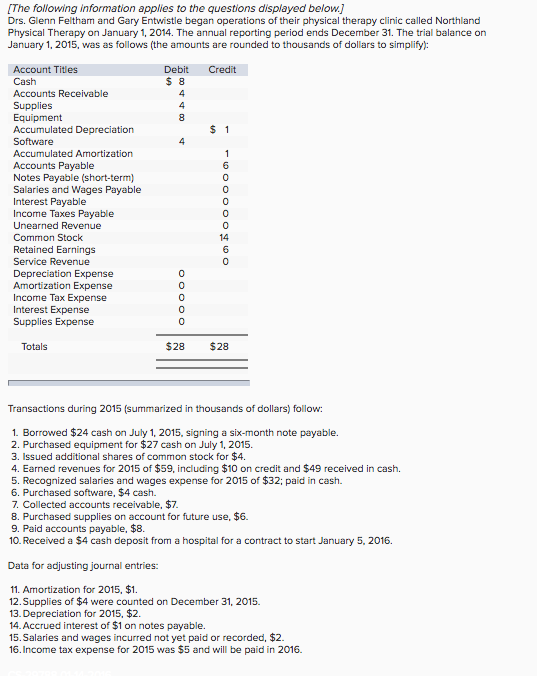Question
1. Record journal entries for transactions (1) through (10). (If no entry is required for a transaction/event, select No Journal Entry Required in the first

1. Record journal entries for transactions (1) through (10). (If no entry is required for atransaction/event, select "No Journal Entry Required" in the first account field. Enter your answers in thousands of dollars.)
2. Set up T-accounts for the accounts on the trial balance. Enter beginning balances and post the transactions 1-10, adjusting entries 11-16, and closing entry. (Enter your answers in thousands of dollars.)
3. Post the journal entries from requirement 2 to T-accounts and prepare an unadjusted trial balance. (Enter your answers in thousands of dollars.)
4. Record the adjusting journal entries (11) through (16). (If no entry is required for a transaction/event, select "No Journal Entry Required" in the first account field. Enter your answers in thousands of dollars.)
5. Post the adjusting entries from requirement 4 and prepare an adjusted trial balance. (Enter your answers in thousands of dollars.)
6. Prepare an income statement (Enter your answers in thousands of dollars.)
Prepare the statement of retained earnings. (Enter your answers in thousands of dollars.)
Prepare the balance sheet. (Enter your answers in thousands of dollars. Amounts to be deducted should be indicated by a minus sign)
7. Prepare the closing journal entry. (If no entry is required for a transaction/event, select "No Journal Entry Required" in the first account field. Enter your answers in thousands of dollars.)
| 8. Post the closing entry from requirement 7 and prepare a post-closing trial balance. (Enter your answers in thousands of dollars.) |
[The following information applies to the questions displayed below. Drs. Glenn Feltham and Gary Entwistle began operations of their physical therapy clinic called Northland Physical Therapy on January 1, 2014. The annual reporting period ends December 31. The trial balance on January 1, 2015, was as follows (the amounts are rounded to thousands of dollars to simplify Account Titles Debit Credit Accounts Receivable Supplies Accumulated Depreciation Accumulated Amortization Accounts Payable Notes Payable (short-term) Salaries and Wages Payable Interest Payable Income Taxes Payable 0 0 0 0 14 Common Stock Retained Earnings Service Revenue Depreciation Expense Amortization Expense Income Tax Expense Interest Expense Supplies Expense 0 0 Totals 528 $28 Transactions during 2015 (summarized in thousands of dollars) follow: 1. Borrowed $24 cash on July 1, 2015, signing a six-month note payable. 2. Purchased equipment for $27 cash on July 1, 2015. 3. Issued additional shares of common stock for $4. 4. Earned revenues for 2015 of $59, including $10 on credit and $49 received in cash. 5. Recognized salaries and wages expense for 2015 of $32; paid in cash. 6. Purchased software, $4 cash. 7. Collected accounts receivable, $7 8. Purchased supplies on account for future use, $6. 9. Paid accounts payable, $8 10. Received a $4 cash deposit from a hospital for a contract to start January 5, 2016. Data for adjusting journal entries: 11. Amortization for 2015, $1. 12.Supplies of $4 were counted on December 31, 2015. 13. Depreciation for 2015, $2. 14. Accrued interest of $1 on notes payable. 15.Salaries and wages incurred not yet paid or recorded, $2. 16.Income tax expense for 2015 was $5 and will be paid in 2016
Step by Step Solution
There are 3 Steps involved in it
Step: 1

Get Instant Access to Expert-Tailored Solutions
See step-by-step solutions with expert insights and AI powered tools for academic success
Step: 2

Step: 3

Ace Your Homework with AI
Get the answers you need in no time with our AI-driven, step-by-step assistance
Get Started


